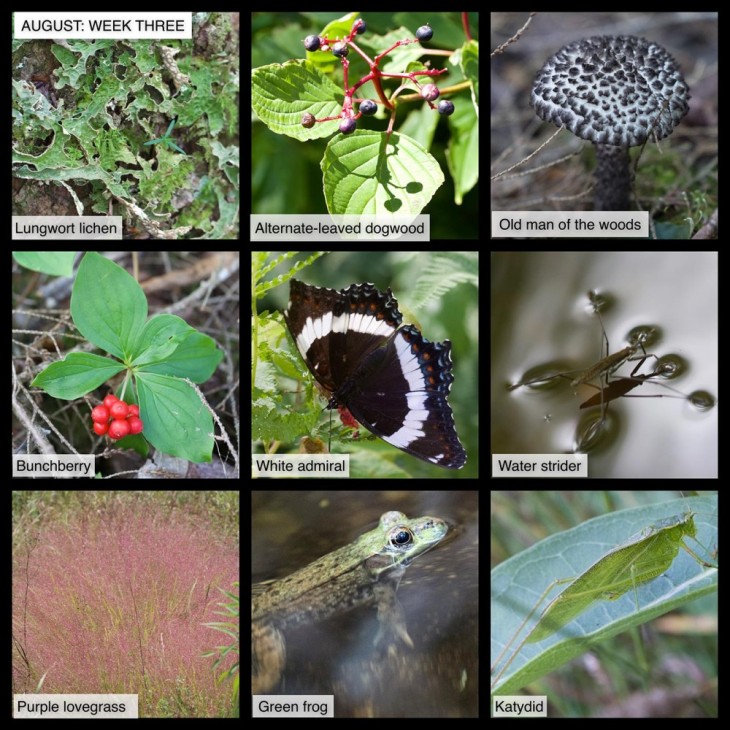This Week in the Woods, we’ve noticed bright green lungwort lichen, which grows on the trunks of both conifers and hardwoods. Because of its lettuce-like appearance, it’s easy to mistake for a plant. But in fact like all lichens, it’s a complicated experiment in group living. In lungwort’s case, the combo includes green algae, cyanobacteria, and fungi. Lungwort fixes nitrogen from the air, which eventually ends up in the forest soil. For more on that topic, see this profile from the U.S. Forest Service, and for an overview of what lichen are and how they live, check out this Outside Story essay by Joe Rankin.
Alternate-leaved dogwood, also called pagoda dogwood, is bearing blue fruit now, and some of its leaves are changing to their rosy autumn color. The Wild Seed Project has an extensive write-up of this shrub, praising both its beauty and high wildlife food value and also, sadly, noting that now-extinct “passenger pigeons…relished the dogwood’s fruit, hence another common, and very poignant name, pigeonberry.”
Fervent fungi fans that we are, we were excited to find an old man of the woods last weekend. There are two closely related species in the Strobilomyces genus that share this name (depending on which field guide you consult – some are more persnickety). As noted by Lawrence Millman in Fascinating Fungi of New England, the Latin name means, “resembling a pinecone.” Which it kind of does…maybe? Certainly more than it resembles an old man.
Back to the topic of dogwoods and berries – in early June, we noted the flowers of bunchberry, a small, ground-hugging member of the dogwood family. Here’s that link. The plant has now produced bright red berries – you can find it in a variety of locations, including along hiking trails in shady woods, but a typical site is in moist soil near wetlands.
White admirals are all-summer butterflies. The ones we’ve seen recently have looked worse for wear. You’ll often find them in clearings in forests, as well as in edge habitat, so it’s no surprise that their caterpillar host plants include early forest succession trees such as birch, aspen, and cherry. As adults, although they visit flowers, the males especially are also known to “puddle,” or gather, at less scenic locations, such as muddy flats and on top of animal dung. Here’s an Outside Story article by Susan Shea which explains how and why admirals, swallowtails and other butterflies harvest salts and other nutrients. And here’s a YouTube video from Texas, with simple instructions on how to make a puddling station – a fun activity with kids.
Water striders have been coasting around water bodies all summer and are still going strong. As entomologist Declan McCabe explains in this Outside Story essay, their long legs “distribute body weight over a wide area, and aided by water repellent hairs, allow the insect to coast across the water’s surface tension.” In other words, despite their aquatic habitat, these insects stay dry, even in rainstorms.
Purple lovegrass is in full color now, although it’s more pink than purple. Because each blade is so tiny, clumps of it have a smoky appearance. Often you find this bunch grass growing in sandy meadows, providing a vivid color contrast to the blackberries and goldenrod. Here’s a profile from The Native Plant Trust.
The simply named green frog is a common species in ponds and other water bodies. As noted in this profile from the Vermont Reptile and Amphibian Atlas, individual green frogs vary in appearance. When in doubt, look for this combination: a raised dark ridge on either side of the back (wood frogs have this feature as well), green coloring on the face (a trait shared with bullfrogs), and (especially in the males) a sizeable tympanum (basically a pad that transmits sound to the frog’s ear). The males also have a distinctive call, often described as a banjo twang, though they’ve quieted down this late in summer. Here’s an oddly mesmerizing YouTube video showing some male green frogs calling in mating season, and a related link to Mary Holland’s Naturally Curious blog.
Katydids – gorgeous green insects with super-long antennae – are remarkably well camouflaged against green leaves, and often lurk high in the trees, which makes them very difficult to find, and photograph! Although you may not see them, there’s no way to avoid hearing them on August evenings. Here’s yet another excellent Outdoor Radio segment from the Vermont Center for Ecostudies, sharing this late summer sound and describing how male katydids and crickets court their mates through a process of stridulation – in other words, making noise by rubbing together specialized structures on their wings. And here’s an Outside Story essay by Meghan McCarthy McPhaul on the topic, noting that the “insect orchestra” has been playing for over 200 million years.
In this difficult period, many of us find joy in observing local nature, and many families are seeking outdoor enrichment opportunities for children. Here are nine photographs taken this past week, most within 15 miles of the Northern Woodlands office in Lyme, New Hampshire. We hope you enjoy using this grid as a prompt for your own explorations, or as the basis for a game of family forest tic-tac-toe.
What are you seeing in the woods this week? Share your images with us on Facebook, or submit a special photo for possible inclusion in our monthly online Reader Photo Gallery.


